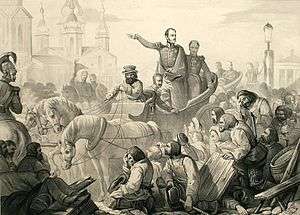Cholera Riots
Cholera Riots refers to civil disturbances associated with an outbreak or epidemic of cholera.

In Russia
The Cholera Riots (Холерные бунты in Russian) were the riots of the urban population, peasants and soldiers in 1830–1831 when the second cholera pandemic reached Russia.
The riots were caused by the anti-cholera measures, undertaken by the tsarist government, such as quarantine, armed cordons and migratory restrictions. Influenced by rumors of deliberate contamination of ordinary people by government officials and doctors, agitated mobs started raiding police departments and state hospitals, killing hated functionaries, officers, landowners and gentry. In November 1830, the citizens of Tambov attacked their governor, but they were soon suppressed by the regular army. In June 1831, there was a riot on the Sennaya Square in St.Petersburg, but the agitated workers, artisans and house-serfs were dispersed by the army, reinforced with artillery. The riots went especially out of control in Sevastopol and in military settlements of the Novgorod guberniya. The rebels established their own court, electoral committees out of soldiers and non-commissioned officers and conducted propaganda among the serfs.
Further cholera riots in 1892 were aggressively suppressed by the tsarist government.[1]
On August 29, 1909 The New York Times reported more cholera riots in Russia.[2][3]
In Great Britain
Asiatic cholera reached Britain in 1831, with the main epidemic occurring during 1832. There was widespread public fear, and the political and medical response to this new disease was variable and inadequate. In the summer of 1832, a series of cholera riots occurred in various towns and cities throughout Britain, frequently directed against the authorities, doctors, or both. The city of Liverpool, in the northwest of England, experienced more riots than elsewhere. Between 29 May and 10 June 1832, eight major street riots occurred, with several other minor disturbances. The object of the crowd’s anger was the local medical fraternity. The public perception was that cholera victims were being removed to the hospital to be killed by doctors in order to use them for anatomical dissection. "Bring out the Burkers" was one cry of the Liverpool mobs, referring to the Burke and Hare scandal four years earlier, when two men had murdered people in Edinburgh in order to sell their bodies for dissection to the local anatomy school. This issue was of special concern to the Liverpool citizenry because in 1826, thirty-three bodies had been discovered on the Liverpool docks, about to be shipped to Scotland for dissection. Two years later a local surgeon, William Gill, was tried and found guilty of running an extensive local grave robbing system to supply corpses for his dissection rooms.
The widespread cholera rioting in Liverpool was thus as much related to local anatomical issues as it was to the national epidemic. The riots ended relatively abruptly, largely in response to an appeal by the Roman Catholic clergy read from church pulpits, and also published in the local press. In addition, a respected local doctor, James Collins, published a passionate appeal for calm. The Liverpool Cholera Riots of 1832 demonstrate the complex social responses to epidemic disease, as well as the fragile interface between the public and the medical profession.[4]
In the same year, riots were reported in Exeter as people objected to the burial of cholera-infected bodies in local graveyards.[5] Gravediggers were attacked. The local authorities had instituted regulations for the disposal of cholera-infected corpses and their clothes and bedding. Even the collection of clothing could result in riot or disorder as family and friends argued over the amount of compensation to be paid.
In Germany
In 1893 fatal riots broke out in Hamburg, Germany during the fifth cholera pandemic, because the public objected to sanitary officers trying to enforce regulations for the prevention of spread of the disease.[6] The crowd beat to death a sanitary officer and one of the policemen sent to protect them. Troops were called out and dispersed the crowd with fixed bayonets.
In Zimbabwe
In December 2008, baton-wielding riot police broke up protests in Harare and detained dozens, as the death toll of a cholera epidemic neared 600 in Zimbabwe's worsening health and economic crises. Trade unionists protesting against limits on cash withdrawals were beaten by security forces in Harare, while police also dispersed doctors and nurses who tried to hand in a petition against the collapse of the health system.[7]
References
- Friedgut, Theodore H. (25 June 1987). "Labor Violence and Regime Brutality in Tsarist Russia: The Iuzovka Cholera Riots of 1892". Slavic Review. 46 (2): 245–265. doi:10.2307/2498910. JSTOR 2498910.
- "The New York Times from New York, New York on August 29, 1909 · Page 1". Retrieved 3 September 2018.
- Cohn Jr. (9 March 2018). Epidemics: Hate and Compassion from the Plague of Athens to AIDS. Oxford University Press. p. 207. ISBN 9780192551580.
- Sean Burrell. "The Liverpool Cholera Epidemic of 1832 and Anatomical Dissection—Medical Mistrust and Civil Unrest". oxfordjournals.org.
- David Cornforth. "Exeter Memories – Cholera in 1832". exetermemories.co.uk.
- "CHOLERA RIOT IN HAMBURG; SANITARY OFFICERS AGAIN ATTACKED BY A MOB. One of Them Knocked Down and Kicked and Trampled to Death – A Policeman Also Killed by the Infuriated Crowd – Troops Charged the Mob with Fixed Bayonets and Dispersed It, but Not Until It Had Injured Several Persons by Its Violence" (PDF). Retrieved 25 June 2017.
- "AFP: Riot police break up Zimbabwe protests as cholera deaths mount". Retrieved 25 June 2017.